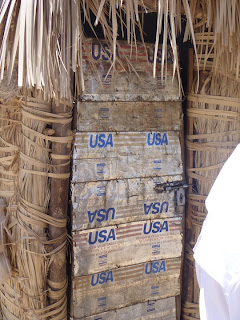Week four, and we're still going strong.
This week of ecology was dominated by our independent research projects. In case you didn't read the last post, we were all instructed to come up with a feasible experiment, perform it, and then write a paper on our results. But we still had a couple of class trips this week, my favorite being our visit to the pilot farm.
The Turkana Basin Institute recently invested in creating a small farm for the people in the area. The idea was to reduce their dependence on food aid by teaching them to grow crops for themselves. The farm consists of a small plot of land situated right next to the river. It's very difficult to grow things in this environment because of the heat and the poor soil quality, so tending the crops requires constant effort. To water them, they set up a foot-powered pump that siphons water from the river. The people grow eggplants, onions, watermelon, spinach, and tomatoes.
 |
| My classmate Hui on the water pump |
After we took a tour, we sat down and talked with the women. One of the questions they asked us was, "it seems that there aren't many men in America, does this mean that women are the powerful ones?" (of our ten students, only three are male). We answered that it depends, but sometimes. When we were done talking with the women, they all sang a song for us. For our turn, we opted to sing "Yellow Submarine", but somehow managed to forget the words halfway into the song. Woops!
Later that day we ate eggplant purchased from the farm for lunch. It was delicious!
The rest of my week mostly consisted of collecting data for my project and writing the paper. I was attempting to measure the effect of goat grazing on a particular plant: Indigofera spinosa. Indigofera is a small shrub covered in very prickly needles. Not a fun thing to step in, but somehow the goats have no problem eating it.
TBI is surrounded by a fence that keeps the goats from eating getting inside. So by comparing the vegetation inside the fence to outside, one can get a reasonable estimate of how goats are affecting this landscape. For my data, I collected vegetation density and reproductive success on the plants inside and outside the compound. I also designed a survey and administered it to some goat herders in the area.
After I crunched all of the numbers I found that there is six times more Indigofera inside TBI than outside, and each plant produces on average six times more seed pods. If you just compare pictures of the plants inside and outside the fence, you can clearly see the size difference:
 |
| This is from inside TBI, note the long branches on all of the plants |
 | |
| And this is a typical plant that has been grazed over, also notice that there are far fewer of them |
 | |
| A door made from unwound vegetable oil cans |
But convincing people to own fewer goats is difficult because they are at the basis of many social interactions. For example, giving 150 goats for a bride-price is not uncommon around here. Guess I'm not getting married anytime soon!
 |
| The assembly at the school |
On Saturday morning we took a class trip to a primary school in Lodwar. To celebrate the life of nobel prize winner Wangari Maathi, we planted trees around the school. It was a great time, and it's always fun to interact with the local kids. After visiting the school, we went to an IDP camp (internally displaced peoples) and did the same thing. Again, we got a little music performance from the crowd.
 | |
| My classmate Sarah having a wonderful time with the kids |
 |
| The beautiful flower of an eggplant |


No comments:
Post a Comment